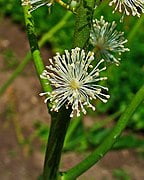Actaea racemosa

Actaea racemosa, the black cohosh, black bugbane, black snakeroot, or fairy candle (syn. Cimicifuga racemosa), is a species of flowering plant of the family Ranunculaceae. It is native to eastern North America from the extreme south of Ontario to central Georgia, and west to Missouri and Arkansas. It grows in a variety of woodland habitats, and is often found in small woodland openings. The roots and rhizomes were used in traditional medicine by Native Americans. Although its extracts are manufactured as herbal medicines and dietary supplements, black cohosh is not well-studied or recommended for safe and effective use in treating menopause symptoms or any disease.[2]
The plant species has a history of taxonomic uncertainty dating back to Carl Linnaeus, who—on the basis of morphological characteristics of the inflorescence and seeds—had placed the species into the genus Actaea. This designation was later revised by Thomas Nuttall reclassifying the species to the genus Cimicifuga. Nuttall’s classification was based solely on the dry follicles produced by black cohosh, which are typical of species in Cimicifuga.[3] However, recent data from morphological and gene phylogeny analyses demonstrate that black cohosh is more closely related to species of the genus Actaea than to other Cimicifuga species. This has prompted the revision to Actaea racemosa as originally proposed by Linnaeus.[3] Blue cohosh (Caulophyllum thalictroides), despite its similar common name belongs to another family, the Berberidaceae, is not closely related to black cohosh, and may be unsafe if used together.[4]
